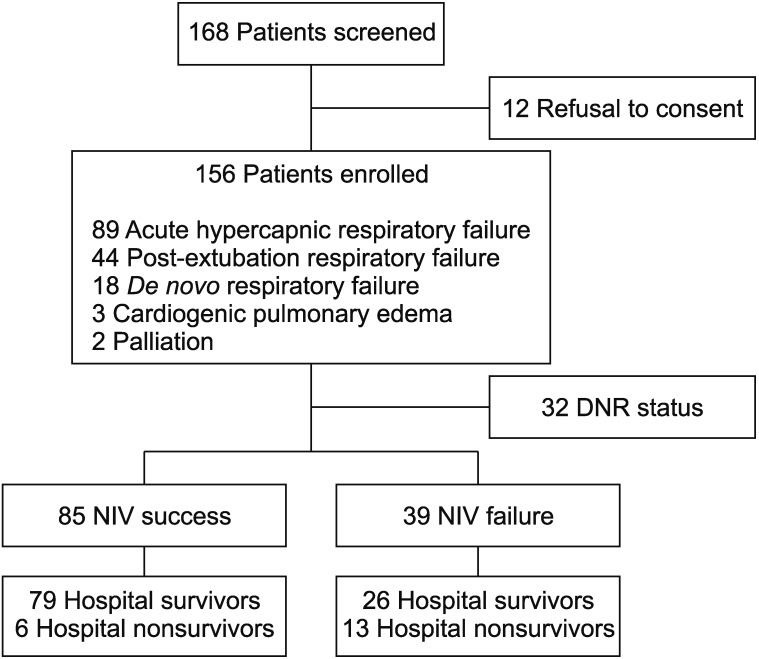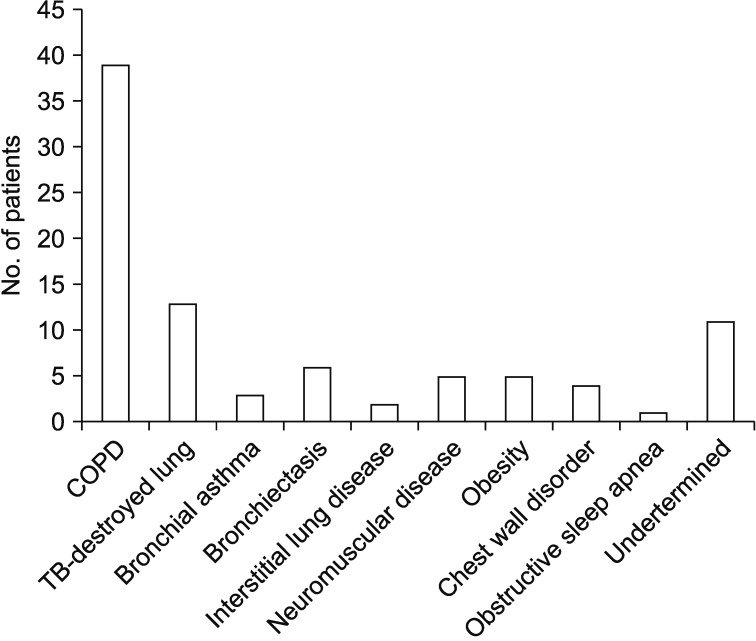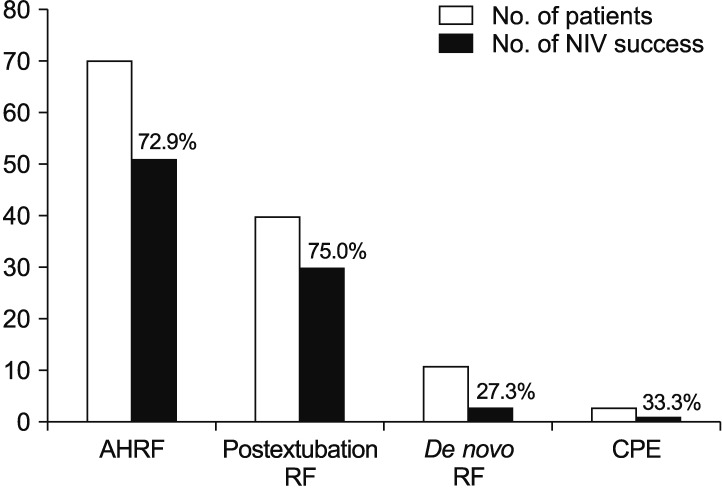Tuberc Respir Dis.
2019 Jul;82(3):242-250. 10.4046/trd.2018.0064.
Current Status of Noninvasive Ventilation Use in Korean Intensive Care Units: A Prospective Multicenter Observational Study
- Affiliations
-
- 1Department of Pulmonary, Allergy and Critical Care Medicine, Hallym University Sacred Heart Hospital, Anyang, Korea. f2000tj@gmail.com
- 2Department of Internal Medicine, Gangnam Severance Hospital, Yonsei University College of Medicine, Seoul, Korea.
- 3Department of Pulmonary and Critical Care Medicine, Yeungnam University Hospital, Daegu, Korea.
- 4Department of Pulmonary and Critical Care Medicine, Inje University Sanggye Paik Hospital, Seoul, Korea.
- 5Department of Internal Medicine, Kyeimyung University Dongsan Hospital, Daegu, Korea.
- 6Department of Pulmonary and Critical Care Medicine, Kyung Hee University Hospital at Gangdong, Seoul, Korea.
- 7Department of Pulmonary and Critical Care Medicine, Chungnam University Hospital, Daejeon, Korea.
- 8Department of Internal Medicine, Pusan National University Hospital, Busan, Korea.
- 9Department of Pulmonary, Critical Care and Sleep Medicine, St. Paul's Hospital, College of Medicine, The Catholic University of Korea, Seoul, Korea.
- 10Division of Pulmonary and Critical Care Medicine, Department of Internal Medicine, Inje University Ilsan Paik Hospital, Goyang, Korea.
- 11Department of Pulmonary, Allergy and Critical Care Medicine, Hallym University Kangnam Sacred Heart Hospital, Seoul, Korea.
- 12Department of Internal Medicine, Hanyang University Guri Hospital, Guri, Korea.
- 13Department of Pulmonary, Allergy and Critical Care Medicine, Chonbuk National University Hospital, Jeonju, Korea.
- KMID: 2450902
- DOI: http://doi.org/10.4046/trd.2018.0064
Abstract
- BACKGROUND
Data on noninvasive ventilation (NIV) use in intensive care units (ICUs) are very limited in South Korea.
METHODS
A prospective observational study was performed in 20 ICUs of university-affiliated hospitals from June 2017 to February 2018. Adult patients (age>18 years) who were admitted to the ICU and received NIV treatment for acute respiratory failure were included.
RESULTS
A total of 156 patients treated with NIV were enrolled (mean age, 71.9±11.6 years). The most common indications for NIV were acute hypercapnic respiratory failure (AHRF, n=89) and post-extubation respiratory failure (n=44). The main device for NIV was an invasive mechanical ventilator with an NIV module (61.5%), and the majority of patients (87.2%) used an oronasal mask. After the exclusion of 32 do-not-resuscitate patients, NIV success rate was 68.5% (85/124); ICU and hospital mortality rates were 8.9% and 15.3%, respectively. However, the success rate was lower in patients with de novo respiratory failure (27.3%) compared to that of patients with AHRF (72.8%) or post-extubation respiratory failure (75.0%). In multivariate analysis, immunocompromised state, de novo respiratory failure, post-NIV (2 hours) respiratory rate, NIV mode (i.e., non-pressure support ventilation mode), and the change of NIV device were significantly associated with a lower success rate of NIV.
CONCLUSION
AHRF and post-extubation respiratory failure were the most common indications for NIV in Korean ICUs. Overall NIV success was achieved in 68.5% of patients, with the lowest rate in patients with de novo respiratory failure.
Keyword
MeSH Terms
Figure
Cited by 1 articles
-
Utilization of pain and sedation therapy on noninvasive mechanical ventilation in Korean intensive care units: a multi-center prospective observational study
Taehee Kim, Jung Soo Kim, Eun Young Choi, Youjin Chang, Won-Il Choi, Jae-Joon Hwang, Jae Young Moon, Kwangha Lee, Sei Won Kim, Hyung Koo Kang, Yun Su Sim, Tai Sun Park, Seung Yong Park, Sunghoon Park, Jae Hwa Cho
Acute Crit Care. 2020;35(4):255-262. doi: 10.4266/acc.2020.00164.
Reference
-
1. Brochard L, Mancebo J, Wysocki M, Lofaso F, Conti G, Rauss A, et al. Noninvasive ventilation for acute exacerbations of chronic obstructive pulmonary disease. N Engl J Med. 1995; 333:817–822. PMID: 7651472.
Article2. Gray A, Goodacre S, Newby DE, Masson M, Sampson F, Nicholl J, et al. Noninvasive ventilation in acute cardiogenic pulmonary edema. N Engl J Med. 2008; 359:142–151. PMID: 18614781.
Article3. Bourke SC, Tomlinson M, Williams TL, Bullock RE, Shaw PJ, Gibson GJ. Effects of non-invasive ventilation on survival and quality of life in patients with amyotrophic lateral sclerosis: a randomised controlled trial. Lancet Neurol. 2006; 5:140–147. PMID: 16426990.
Article4. Kohnlein T, Windisch W, Kohler D, Drabik A, Geiseler J, Hartl S, et al. Non-invasive positive pressure ventilation for the treatment of severe stable chronic obstructive pulmonary disease: a prospective, multicentre, randomised, controlled clinical trial. Lancet Respir Med. 2014; 2:698–705. PMID: 25066329.5. Zarbock A, Mueller E, Netzer S, Gabriel A, Feindt P, Kindgen-Milles D. Prophylactic nasal continuous positive airway pressure following cardiac surgery protects from postoperative pulmonary complications: a prospective, randomized, controlled trial in 500 patients. Chest. 2009; 135:1252–1259. PMID: 19017864.6. Murgu SD, Pecson J, Colt HG. Bronchoscopy during noninvasive ventilation: indications and technique. Respir Care. 2010; 55:595–600. PMID: 20420731.7. Nava S, Ferrer M, Esquinas A, Scala R, Groff P, Cosentini R, et al. Palliative use of non-invasive ventilation in end-of-life patients with solid tumours: a randomised feasibility trial. Lancet Oncol. 2013; 14:219–227. PMID: 23406914.
Article8. Crimi C, Noto A, Princi P, Esquinas A, Nava S. A European survey of noninvasive ventilation practices. Eur Respir J. 2010; 36:362–369. PMID: 20075052.
Article9. Demoule A, Chevret S, Carlucci A, Kouatchet A, Jaber S, Meziani F, et al. Changing use of noninvasive ventilation in critically ill patients: trends over 15 years in francophone countries. Intensive Care Med. 2016; 42:82–92. PMID: 26464393.10. Demoule A, Girou E, Richard JC, Taille S, Brochard L. Increased use of noninvasive ventilation in French intensive care units. Intensive Care Med. 2006; 32:1747–1755. PMID: 16799775.
Article11. Schnell D, Timsit JF, Darmon M, Vesin A, Goldgran-Toledano D, Dumenil AS, et al. Noninvasive mechanical ventilation in acute respiratory failure: trends in use and outcomes. Intensive Care Med. 2014; 40:582–591. PMID: 24504643.
Article12. Maheshwari V, Paioli D, Rothaar R, Hill NS. Utilization of noninvasive ventilation in acute care hospitals: a regional survey. Chest. 2006; 129:1226–1233. PMID: 16685013.13. Hong SB, Oh BJ, Kim YS, Kang EH, Kim CH, Park YB, et al. Characteristics of mechanical ventilation employed in intensive care units: a multicenter survey of hospitals. J Korean Med Sci. 2008; 23:948–953. PMID: 19119434.
Article14. Patel BK, Wolfe KS, Pohlman AS, Hall JB, Kress JP. Effect of noninvasive ventilation delivered by helmet vs face mask on the rate of endotracheal intubation in patients with acute respiratory distress syndrome: a randomized clinical trial. JAMA. 2016; 315:2435–2441. PMID: 27179847.15. Yoo JW, Synn A, Huh JW, Hong SB, Koh Y, Lim CM. Clinical efficacy of high-flow nasal cannula compared to noninvasive ventilation in patients with post-extubation respiratory failure. Korean J Intern Med. 2016; 31:82–88. PMID: 26767861.
Article16. Carpe-Carpe B, Hernando-Arizaleta L, Ibanez-Perez MC, Palomar-Rodriguez JA, Esquinas-Rodriguez AM. Evolution of the use of noninvasive mechanical ventilation in chronic obstructive pulmonary disease in a Spanish region, 1997–2010. Arch Bronconeumol. 2013; 49:330–336. PMID: 23856438.
Article17. Sinuff T, Cook D, Randall J, Allen C. Noninvasive positive-pressure ventilation: a utilization review of use in a teaching hospital. CMAJ. 2000; 163:969–973. PMID: 11068568.18. Rochwerg B, Brochard L, Elliott MW, Hess D, Hill NS, Nava S, et al. Official ERS/ATS clinical practice guidelines: noninvasive ventilation for acute respiratory failure. Eur Respir J. 2017; 50:1602426. PMID: 28860265.
Article19. Ferrer M, Valencia M, Nicolas JM, Bernadich O, Badia JR, Torres A. Early noninvasive ventilation averts extubation failure in patients at risk: a randomized trial. Am J Respir Crit Care Med. 2006; 173:164–170. PMID: 16224108.20. Nava S, Gregoretti C, Fanfulla F, Squadrone E, Grassi M, Carlucci A, et al. Noninvasive ventilation to prevent respiratory failure after extubation in high-risk patients. Crit Care Med. 2005; 33:2465–2470. PMID: 16276167.
Article21. Demoule A, Girou E, Richard JC, Taille S, Brochard L. Benefits and risks of success or failure of noninvasive ventilation. Intensive Care Med. 2006; 32:1756–1765. PMID: 17019559.
Article22. Viires N, Sillye G, Aubier M, Rassidakis A, Roussos C. Regional blood flow distribution in dog during induced hypotension and low cardiac output: spontaneous breathing versus artificial ventilation. J Clin Invest. 1983; 72:935–947. PMID: 6886012.
Article23. Kallet RH, Diaz JV. The physiologic effects of noninvasive ventilation. Respir Care. 2009; 54:102–115. PMID: 19111110.24. Dysart K, Miller TL, Wolfson MR, Shaffer TH. Research in high flow therapy: mechanisms of action. Respir Med. 2009; 103:1400–1405. PMID: 19467849.
Article25. Frat JP, Thille AW, Mercat A, Girault C, Ragot S, Perbet S, et al. High-flow oxygen through nasal cannula in acute hypoxemic respiratory failure. N Engl J Med. 2015; 372:2185–2196. PMID: 25981908.
Article26. Carteaux G, Lyazidi A, Cordoba-Izquierdo A, Vignaux L, Jolliet P, Thille AW, et al. Patient-ventilator asynchrony during noninvasive ventilation: a bench and clinical study. Chest. 2012; 142:367–376. PMID: 22406958.27. Ferreira JC, Chipman DW, Hill NS, Kacmarek RM. Bilevel vs ICU ventilators providing noninvasive ventilation: effect of system leaks: a COPD lung model comparison. Chest. 2009; 136:448–456. PMID: 19429723.28. Antonelli M, Conti G, Esquinas A, Montini L, Maggiore SM, Bello G, et al. A multiple-center survey on the use in clinical practice of noninvasive ventilation as a first-line intervention for acute respiratory distress syndrome. Crit Care Med. 2007; 35:18–25. PMID: 17133177.
Article
- Full Text Links
- Actions
-
Cited
- CITED
-
- Close
- Share
- Similar articles
-
- Multicenter Prospective Observational Study about the Usage Patterns of Sedatives, Analgesics and Neuromuscular Blocking Agents in the Patients Requiring More Than 72 Hours Mechanical Ventilation in Intensive Care Units of Korea
- Characteristics of Mechanical Ventilation Employed in Intensive Care Units: A Multicenter Survey of Hospitals
- New Modalities and Modes in Neonatal Ventilation Therapy
- Provision of Enteral Nutrition in the Surgical Intensive Care Unit: A Multicenter Prospective Observational Study
- High-flow nasal cannula oxygen therapy in children: a clinical review




